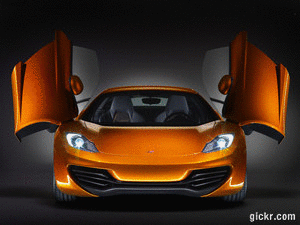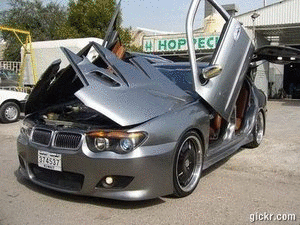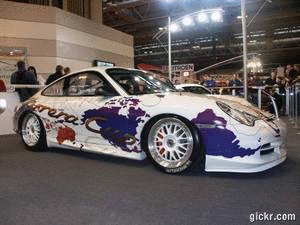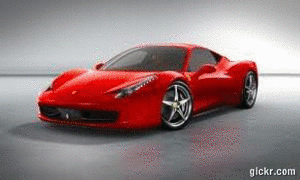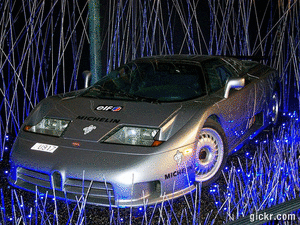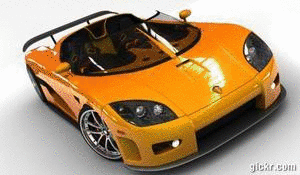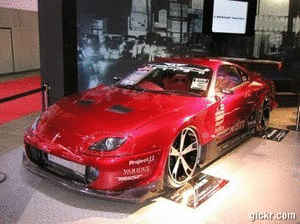Bugatti Veyron, 2009
After having been launched to the world's media and customers at the end of 2005, production of 1001 hp Bugatti Veyron has taken up � full throttle � at the company's factory, the � Atelier �, in Molsheim, near Strasbourg, in France. It is there where the car is assembled by a group of 20 highly specialised technicians. In teams of five they follow the car from the beginning until the end of built. They are fully in charge from the moment the engine is rolled into the assembly hall on a trolley until the finished car rolls out of the � Atelier � under its own steam and on its proper wheels.
An international car
The Bugatti Veyron is an impressive platform of top end automotive technology and - loyal to Bugatti's heritage � nothing is too expensive, nothing is too beautiful � - only the best parts and materials in the trade are used in the production process. And the Bugatti Veyron is a truly international car. One of the key- and most sophisticated parts, the 7 speed-sequential-DSG - double-clutch-gearbox, is made by motor sport specialists Ricardo in the UK, the unique 16 cylinder-8.0-litre-engine comes from the Volkswagen engine plant in Salzgitter in Germany.
The tyres - the first production tyres in the industry homologated for speeds above 400 km/h - are a joint development with Michelin. The carbon fibre monocoque is built by ATR in Italy, the front- and rear- structure in forged aluminium by Heggemann in Germany and the bespoke carbon-ceramic brakes by AP Racing in Great Britain. The paintwork is German, the leather Austrian, the windscreen is manufactured in Finland, and so it goes on.
Only 300 units of the Bugatti Veyron will ever be built. Production started at rate of 50 cars per annum, approximately one a week. Bugatti Automobiles S.A.S., however, is striving to achieve a higher number and plans to get closer to an annual output of a hundred in order to reduce the waiting period for customers.
It does not come as a surprise that over 30% of the Bugatti Veyron orders are tagged for the United States, traditionally by far the most important market for luxury cars. The USA are followed by Germany. 19% of total orders have been placed by German customers to date. The United Kingdom, classically a country with a very strong link to the legendary Bugatti brand, is third with 16% and the Middle East comes fourth with around 15%.
1998 through 1999: four design studies in 15 months' time In April 1998, the Volkswagen Group took over the Bugatti trademark, presenting the brand to the public for the first time at the International Motor Show in Paris with a study for a twodoor coupe it had commissioned Italdesign to create: the Bugatti EB 118. A few months later, in March 1999, at the Geneva Motor Show, a design of the EB 218, itself also created at Italdesign, caused a sensation with a four-door saloon using the same 18-cylinder, 6.3 litre engine with 555 hp.
This was followed, the same year, at the IAA in Frankfurt, by the centre-engine design, the Bugatti EB 18/3 Chiron; once again Giugiaro was responsible for the design. And shortly thereafter, in Tokyo, the Bugatti EB 18/4 Veyron celebrated its world premiere, a model designed at the 'Volkswagen Centre of Excellence Design' under the directorship of Hartmut Warkuss.
No more than nearly a year later, in autumn 2000 in Paris, the Bugatti Veyron 16.4 was shown for the first time. The Bugatti Veyron 16.4 with the ultimate in performance features, the 1001 hp, 8- litre, 16-cylinder engine and its technological specifications - 1250 Nm at 2,200 rpm, peak speed of more than 400 km/h, four turbochargers and permanent four-wheel drive - features that have remained in place to this day, celebrated its debut at the IAA in Frankfurt in September of 2001.
2003: New team - new objectives
In 2001, the decision was made to go into serial production of the Bugatti Veyron 16.4 with a lot not to exceed 300 cars. In December of the following year, 'Bugatti Automobiles S.A.S.' was established, a subsidiary of 'Volkswagen France' with headquarters in Molsheim. And nearly a year to the day thereafter, at the end of 2003, Dr Thomas Bscher took overall charge of the Bugatti project as the new President of 'Bugatti Automobiles S.A.S.'. Appointed to assist him was D. Wolfgang Schreiber, serving as technical director and simultaneously as head of 'Bugatti Engineering GmbH' in Wolfsburg, where all of the development work for the new Bugatti is co-ordinated and, in part, carried out. His functional mission was to put the Bugatti Veyron 16.4 on the road.
The new team subjected the entire project to a technological and financial feasibility study commissioned, among other things, to develop a realistic timeframe for the launch of production of the new Bugatti. Shortly before the 2004 Geneva Motor Show, the Executive Board at the Group approved plans for the 'new' Veyron project, scheduling production to begin in September 2005. This schedule has been met to this day.
The Bugatti Veyron: An unrivalled synthesis of top performance with the everyday
This is made all the more remarkable by the fact that the Bugatti Veyron 16.4, despite its very limited production, is called upon to meet all of the specifications of the VW Group in their entirety. This means innumerable time-consuming trials and tests throughout the entire world, all devoted to the fulfilment of a single objective: to measure up to the strict, indeed relentless quality and quality-assurance standards the company has laid down. This ensures that this super sports car will be suitable for everyday driving as well, to a degree never before witnessed in any other serial-production vehicle of this type.
In the world of modern, serial-production automobiles, the synthesis which has been brought to fruition in the Bugatti Veyron 16.4 is a synthesis between easy and problem-free operation in day-to-day traffic and breathtaking driving in the high-performance area. A reference which would be music to the ears of Ettore Bugatti, whose early successes themselves were rooted in this unique combination.
Extensive construction work in Molsheim
Tandem to the ongoing activities in the product area, extensive construction work has been launched at the location in Molsheim. To begin with, the Ch�teau St. Jean - an edifice that Ettore Bugatti never used as a residence but rather only as a form of what, in today's parlance would be termed a customer service centre, was completely renovated.
The two stalls located to the south and the north of the castle, which in Bugatti's day served as stables, were telemetrically surveyed, dismantled and, using as many of the original elements of the structure, such as wall segments and woodwork, as were still usable, reconstructed in a faithful copy of the original structures. In this new 'Bugatti Era', these structures will for the most part have an administrative character; in one of the spaces, clients will also be able to receive their Bugatti Veyron in an historical setting.
The core of the investments made in Molsheim is the 'Atelier' in which production of the Bugatti Veyron 16.4 is beginning in September 2005. In its architectural form, this modern production facility has been given stylistic features dipping back into the history of the automotive brand. With a southern exposure, the light-filled, glassed main hall is only partly evocative of an automobile-manufacturing operation in the classical sense of the term - it reminds the beholder more of a 'Formula One laboratory'. The setting is dominated by clinical cleanliness and precision workmanship with highly developed component parts. And yet the 'Atelier' can still hold its own against the 'major players'.
A runway for the measurement of relevant functional-performance data and a generously proportioned water-spraying system for testing vehicle water tightness are to be found here, alongside a light chamber under the glaring lamps of which the slightest inconsistency in a car's paintwork mercilessly catches the eye. A small test course has been laid out in the green spaces in front of the building. It can be used to supplement the road-test programme compulsory for all Veyrons and which concludes the vehicle's production process. A logistics centre erected next to the 'Atelier' rounds out the complex of buildings in Molsheim.
Historic location
Thanks to Bugatti, Molsheim has been elevated from anonymity to find its own place on the map - not just of the automotive world. And this is certainly justified, both for the location of Ettore Bugatti's production facilities and his private residence, which is located immediately adjacent. With the purchase of the Ch�teau St. Jean and the property surrounding it, comprising some 140,000 m2 and the site of all other modern-day Bugatti activities as well, this has changed somewhat in purely geographic terms. To be precise, the property is situated in Dorlisheim which, while within sight of the former Bugatti factory, is nevertheless located on the other side of the Bruche River. This has been the source of inspiration for a 'postal sleight of hand' on the part of the new management at Bugatti.
To be able to carry the historic value of the location in Molsheim into the Bugatti future while at the same time satisfying the administrative regulations of the Land, a compromise was negotiated with local authorities. A Solomonic solution was arrived at with the latter - who took a very favourable view of the entire Bugatti project right from the beginning, providing their active support throughout its development. The correct and complete address of Bugatti 'Cru 2005' is: Bugatti Automobiles S.A.S., 1, Ch�teau St. Jean, Dorlisheim, F-67 120 Molsheim.
Bugatti is on the threshold of a new era. Its location is Molsheim. The company is international. Ettore Bugatti was born in 1881 in Italy. He completed his technological instruction in Germany, first with de Dietrich in Niederbronn in Alsace - at the time still a part of Germany - and then at Deutz in Cologne, before he built his first automobile in 1909 in Molsheim. Since 1998, Bugatti has belonged to the Volkswagen Group as a French company with a French headquarters.
The modern-day Bugatti team - every bit as international as the company itself - views the legacy of Ettore Bugatti as both a challenge and an obligation. Thus, Dr Bscher concluded his welcoming remarks with these words: 'We have brought the Bugatti Veyron from a visionary sketch into the reality of the contemporary automotive world. In doing so, we have laid the cornerstone for leading one of the most renowned and reputable makes of automobile from the virtuality of the past into the hard competition of the future. The Bugatti brand will rise to this competition. The Bugatti Veyron is the best sports car in the world, a car the likes of which the world has, in this form, never seen before. Its technical data are second to none. The Bugatti Veyron closes the gap between myth and vision. We believe that we have interpreted Ettore Bugatti's ideas in the 21st century in much the same manner as he himself may have done. Whether we have succeeded in this remains to be shown. But one thing is certain. The Bugatti Veyron is just the beginning. This automotive brand is alive - and will live on.'
An international car
The Bugatti Veyron is an impressive platform of top end automotive technology and - loyal to Bugatti's heritage � nothing is too expensive, nothing is too beautiful � - only the best parts and materials in the trade are used in the production process. And the Bugatti Veyron is a truly international car. One of the key- and most sophisticated parts, the 7 speed-sequential-DSG - double-clutch-gearbox, is made by motor sport specialists Ricardo in the UK, the unique 16 cylinder-8.0-litre-engine comes from the Volkswagen engine plant in Salzgitter in Germany.
The tyres - the first production tyres in the industry homologated for speeds above 400 km/h - are a joint development with Michelin. The carbon fibre monocoque is built by ATR in Italy, the front- and rear- structure in forged aluminium by Heggemann in Germany and the bespoke carbon-ceramic brakes by AP Racing in Great Britain. The paintwork is German, the leather Austrian, the windscreen is manufactured in Finland, and so it goes on.
Only 300 units of the Bugatti Veyron will ever be built. Production started at rate of 50 cars per annum, approximately one a week. Bugatti Automobiles S.A.S., however, is striving to achieve a higher number and plans to get closer to an annual output of a hundred in order to reduce the waiting period for customers.
It does not come as a surprise that over 30% of the Bugatti Veyron orders are tagged for the United States, traditionally by far the most important market for luxury cars. The USA are followed by Germany. 19% of total orders have been placed by German customers to date. The United Kingdom, classically a country with a very strong link to the legendary Bugatti brand, is third with 16% and the Middle East comes fourth with around 15%.
1998 through 1999: four design studies in 15 months' time In April 1998, the Volkswagen Group took over the Bugatti trademark, presenting the brand to the public for the first time at the International Motor Show in Paris with a study for a twodoor coupe it had commissioned Italdesign to create: the Bugatti EB 118. A few months later, in March 1999, at the Geneva Motor Show, a design of the EB 218, itself also created at Italdesign, caused a sensation with a four-door saloon using the same 18-cylinder, 6.3 litre engine with 555 hp.
This was followed, the same year, at the IAA in Frankfurt, by the centre-engine design, the Bugatti EB 18/3 Chiron; once again Giugiaro was responsible for the design. And shortly thereafter, in Tokyo, the Bugatti EB 18/4 Veyron celebrated its world premiere, a model designed at the 'Volkswagen Centre of Excellence Design' under the directorship of Hartmut Warkuss.
No more than nearly a year later, in autumn 2000 in Paris, the Bugatti Veyron 16.4 was shown for the first time. The Bugatti Veyron 16.4 with the ultimate in performance features, the 1001 hp, 8- litre, 16-cylinder engine and its technological specifications - 1250 Nm at 2,200 rpm, peak speed of more than 400 km/h, four turbochargers and permanent four-wheel drive - features that have remained in place to this day, celebrated its debut at the IAA in Frankfurt in September of 2001.
2003: New team - new objectives
In 2001, the decision was made to go into serial production of the Bugatti Veyron 16.4 with a lot not to exceed 300 cars. In December of the following year, 'Bugatti Automobiles S.A.S.' was established, a subsidiary of 'Volkswagen France' with headquarters in Molsheim. And nearly a year to the day thereafter, at the end of 2003, Dr Thomas Bscher took overall charge of the Bugatti project as the new President of 'Bugatti Automobiles S.A.S.'. Appointed to assist him was D. Wolfgang Schreiber, serving as technical director and simultaneously as head of 'Bugatti Engineering GmbH' in Wolfsburg, where all of the development work for the new Bugatti is co-ordinated and, in part, carried out. His functional mission was to put the Bugatti Veyron 16.4 on the road.
The new team subjected the entire project to a technological and financial feasibility study commissioned, among other things, to develop a realistic timeframe for the launch of production of the new Bugatti. Shortly before the 2004 Geneva Motor Show, the Executive Board at the Group approved plans for the 'new' Veyron project, scheduling production to begin in September 2005. This schedule has been met to this day.
The Bugatti Veyron: An unrivalled synthesis of top performance with the everyday
This is made all the more remarkable by the fact that the Bugatti Veyron 16.4, despite its very limited production, is called upon to meet all of the specifications of the VW Group in their entirety. This means innumerable time-consuming trials and tests throughout the entire world, all devoted to the fulfilment of a single objective: to measure up to the strict, indeed relentless quality and quality-assurance standards the company has laid down. This ensures that this super sports car will be suitable for everyday driving as well, to a degree never before witnessed in any other serial-production vehicle of this type.
In the world of modern, serial-production automobiles, the synthesis which has been brought to fruition in the Bugatti Veyron 16.4 is a synthesis between easy and problem-free operation in day-to-day traffic and breathtaking driving in the high-performance area. A reference which would be music to the ears of Ettore Bugatti, whose early successes themselves were rooted in this unique combination.
Extensive construction work in Molsheim
Tandem to the ongoing activities in the product area, extensive construction work has been launched at the location in Molsheim. To begin with, the Ch�teau St. Jean - an edifice that Ettore Bugatti never used as a residence but rather only as a form of what, in today's parlance would be termed a customer service centre, was completely renovated.
The two stalls located to the south and the north of the castle, which in Bugatti's day served as stables, were telemetrically surveyed, dismantled and, using as many of the original elements of the structure, such as wall segments and woodwork, as were still usable, reconstructed in a faithful copy of the original structures. In this new 'Bugatti Era', these structures will for the most part have an administrative character; in one of the spaces, clients will also be able to receive their Bugatti Veyron in an historical setting.
The core of the investments made in Molsheim is the 'Atelier' in which production of the Bugatti Veyron 16.4 is beginning in September 2005. In its architectural form, this modern production facility has been given stylistic features dipping back into the history of the automotive brand. With a southern exposure, the light-filled, glassed main hall is only partly evocative of an automobile-manufacturing operation in the classical sense of the term - it reminds the beholder more of a 'Formula One laboratory'. The setting is dominated by clinical cleanliness and precision workmanship with highly developed component parts. And yet the 'Atelier' can still hold its own against the 'major players'.
A runway for the measurement of relevant functional-performance data and a generously proportioned water-spraying system for testing vehicle water tightness are to be found here, alongside a light chamber under the glaring lamps of which the slightest inconsistency in a car's paintwork mercilessly catches the eye. A small test course has been laid out in the green spaces in front of the building. It can be used to supplement the road-test programme compulsory for all Veyrons and which concludes the vehicle's production process. A logistics centre erected next to the 'Atelier' rounds out the complex of buildings in Molsheim.
Historic location
Thanks to Bugatti, Molsheim has been elevated from anonymity to find its own place on the map - not just of the automotive world. And this is certainly justified, both for the location of Ettore Bugatti's production facilities and his private residence, which is located immediately adjacent. With the purchase of the Ch�teau St. Jean and the property surrounding it, comprising some 140,000 m2 and the site of all other modern-day Bugatti activities as well, this has changed somewhat in purely geographic terms. To be precise, the property is situated in Dorlisheim which, while within sight of the former Bugatti factory, is nevertheless located on the other side of the Bruche River. This has been the source of inspiration for a 'postal sleight of hand' on the part of the new management at Bugatti.
To be able to carry the historic value of the location in Molsheim into the Bugatti future while at the same time satisfying the administrative regulations of the Land, a compromise was negotiated with local authorities. A Solomonic solution was arrived at with the latter - who took a very favourable view of the entire Bugatti project right from the beginning, providing their active support throughout its development. The correct and complete address of Bugatti 'Cru 2005' is: Bugatti Automobiles S.A.S., 1, Ch�teau St. Jean, Dorlisheim, F-67 120 Molsheim.
Bugatti is on the threshold of a new era. Its location is Molsheim. The company is international. Ettore Bugatti was born in 1881 in Italy. He completed his technological instruction in Germany, first with de Dietrich in Niederbronn in Alsace - at the time still a part of Germany - and then at Deutz in Cologne, before he built his first automobile in 1909 in Molsheim. Since 1998, Bugatti has belonged to the Volkswagen Group as a French company with a French headquarters.
The modern-day Bugatti team - every bit as international as the company itself - views the legacy of Ettore Bugatti as both a challenge and an obligation. Thus, Dr Bscher concluded his welcoming remarks with these words: 'We have brought the Bugatti Veyron from a visionary sketch into the reality of the contemporary automotive world. In doing so, we have laid the cornerstone for leading one of the most renowned and reputable makes of automobile from the virtuality of the past into the hard competition of the future. The Bugatti brand will rise to this competition. The Bugatti Veyron is the best sports car in the world, a car the likes of which the world has, in this form, never seen before. Its technical data are second to none. The Bugatti Veyron closes the gap between myth and vision. We believe that we have interpreted Ettore Bugatti's ideas in the 21st century in much the same manner as he himself may have done. Whether we have succeeded in this remains to be shown. But one thing is certain. The Bugatti Veyron is just the beginning. This automotive brand is alive - and will live on.'
